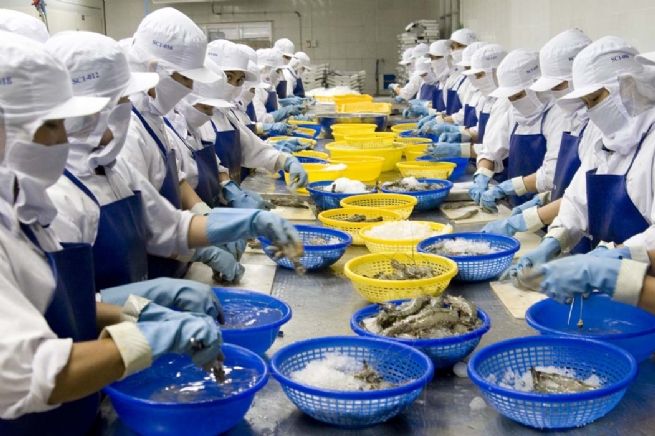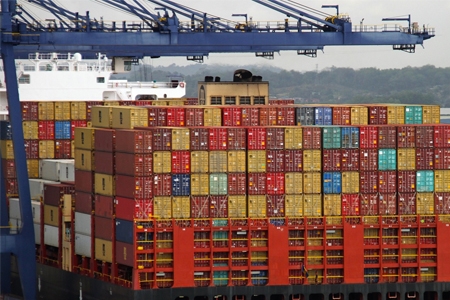Vietnam’s Food and Seafood Export to Canada Keeps Growing
Published: 04/12/19
Vietnam has been a leading trade partner of Canada in ASEAN since 2015. Agricultural and seafood products are important in the two-way trade. In 2018, the country’s food and seafood shipments to Canada valued US$313 million.

The two nations signed the Comprehensive and Progressive Agreement for Trans-Pacific Partnership (CPTPP), effective from January 2019. CPTPP will slash many tariff lines on merchandise of both sides and will bring high-quality products of Canada to Vietnamese consumers at a more reasonable price.
At the “Canadian Delicacies” event hosted in Hanoi by the Embassy of Canada in Vietnam, cuisine made from typical Canadian ingredients were introduced to culinary lovers in the event. Celebrity chef Nathan Fong showed off his cooking of steak-lobster with Vietnamese spices.
The Canadian Delicacies introduced a wide range of Canadian food ingredients, including fish and seafood, beef, maple syrup, apple, blueberries, wine and craft beer. For the first time, the event promoted Canada's Dungeness crab food, a new type of crab recently licensed to be imported into Vietnam.
This program opened a chain of promotion activities of Canadian agricultural and aquatic products in Vietnam. Representatives of Alberta, British Columbia and Nova Scotia states, the Canadian Blueberry Association, the Canadian Beef Association, the Ontario Cattlemen Association, the Ontario Ginseng Growers Association participated in activities in Hanoi. Canadian Minister of Agriculture, Fisheries and Aquaculture Keith Cowell and chef Nathan Fong from Vancouver attended as guests.
Ms. Deborah Paul, Canadian Ambassador to Vietnam, said, “Vietnam and Canada are members of the Comprehensive and Progressive Agreement for Trans-Pacific Partnership (CPTPP), which came into effect in January 2019. CPTPP, which exempts tariffs on goods traded by the two countries, is expected to bring high-quality Canadian products to Vietnamese consumers at more reasonable prices.”
Among signatories to the CPTPP, Canada is among the countries with the highest market opening commitment, with 95% of tariff lines on imported goods slashed to zero, covering 78% of Vietnam's total export value to Canada. Notably, Canada is one of three CPTPP member countries with no bilateral trade agreement with Vietnam.
According to statistics, the two-way trade value tripled from US$1.14 billion in 2010 to US$3.85 billion in 2018. Vietnam always took a surplus in trade with Canada. In 2018 alone, the trade surplus amounted at US$2.14 billion. In the first nine months of 2019, Vietnam’s shipments to Canada exceeded US$2.9 billion, 30.9% higher than a year-ago period.
Vietnam is the fastest-growing trading partner of Canada in Southeast Asia. Vietnam’ value to Canada in 2018 was three times that of Indonesia and the Philippines, and two times that of Thailand and Malaysia.
However, in fact, Vietnam's exports account for less than 1% of Canada’s total imports. Therefore, given the supply of Vietnamese goods and the demand of Canada, Vietnam’s potential for expanding exports to Canada is still huge. Experts forecast that the annual trade growth may reach 20% in the coming years.
Currently, Vietnam has many advantageous exports to Canada such as seafood, wooden furniture, apparel and footwear, vehicles and spare parts, computers, electronic products, telephones and parts. Vietnam imports high-tech products from Canada such as machinery, biological products, technology equipment and raw materials. Especially in recent years, Canadian food and seafood products are favored by Vietnamese consumers.
According to experts, the export structures of Vietnam and Canada do not compete much with each other but complement each other. This is also a good chance to boost the bilateral trade value.
On investment, Canada is currently the 14th largest investor in Vietnam, with 149 projects worth more than US$5 billion or US$32.36 million per project, much higher than the average of a foreign investment project in Vietnam (US$13.97 million). They invest in hotel services, insurance and renewable energy.
Source: vccinews





